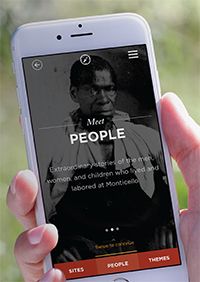FOR IMMEDIATE RELEASE - May 2, 2015
Media Contact: Mia Magruder, 434-984-7596
 Charlottesville, VA – Slavery at Monticello: Life and Work on Mulberry Row, a new app available for iOS and Android devices, introduces visitors to the individuals who lived and worked on Mulberry Row, once the industrial hub and “Main Street” of Thomas Jefferson’s 5,000-acre plantation. “We embrace innovation in our efforts to authentically reveal Jefferson’s world,” said Leslie Greene Bowman, president and CEO of Monticello. “The new app explores the lives of individuals who helped create Monticello but who are not known to most people. Their stories deepen our understanding of the landscape of slavery on the mountaintop.”
Charlottesville, VA – Slavery at Monticello: Life and Work on Mulberry Row, a new app available for iOS and Android devices, introduces visitors to the individuals who lived and worked on Mulberry Row, once the industrial hub and “Main Street” of Thomas Jefferson’s 5,000-acre plantation. “We embrace innovation in our efforts to authentically reveal Jefferson’s world,” said Leslie Greene Bowman, president and CEO of Monticello. “The new app explores the lives of individuals who helped create Monticello but who are not known to most people. Their stories deepen our understanding of the landscape of slavery on the mountaintop.”
Developed with award-winning design firm Bluecadet Interactive, Slavery at Monticello weaves together a rich collection of stories, images and historical content. Using iBeacon and geo-location technology, the app empowers visitors to design their own tour, automatically detecting their location on Mulberry Row and presenting relevant information about the workshops, storehouses and dwellings that once stood nearby.
Through the app, visitors will be able to:
- Meet the people who lived and worked on Mulberry Row and hear their unforgettable stories.
- Visit recreated and vanished buildings where free and enslaved workers lived and labored.
- Learn how Jefferson ran his plantation and see examples of the work conducted at Monticello.
- Hear expert historians and descendants of Monticello’s enslaved community talk about their research and their connections to Monticello.
“We’ve developed a digital experience that deploys familiar technology to explore a lost world,” said Chad Wollerton, Monticello’s Director of Digital Media and Strategy. “The app turns your personal device into a storyteller, an engaging tour guide, and a historical archive.” Monticello’s new, free app is available from the App Store and the Google Play Store. For more information, visit monticello.org/app.
The Slavery at Monticello app is part of the Mountaintop Project, a multi-year effort to restore Monticello as Jefferson knew it, and to tell the stories of the people—enslaved and free—who lived and worked at Monticello.
About the Mountaintop Project
The Mountaintop Project is made possible by a transformational contribution from David M. Rubenstein. Leading support was provided by Fritz and Claudine Kundrun, along with generous gifts and grants from the Sarah and Ross Perot, Jr. Foundation, the Robert H. Smith Family Foundation, Mr. and Mrs. John H. Birdsall, Mr. and Mrs. B. Grady Durham, Ms. Jacqueline B. Mars, Mr. and Mrs. Forrest E. Mars, Jr., Mr. and Mrs. John F. Mars, the National Endowment for the Humanities, Charlotte Moss and Barry Friedberg, the Cabell Foundation, the Richard S. Reynolds Foundation, the Garden Club of Virginia, and additional individuals, organizations, and foundations.
About Monticello
The Thomas Jefferson Foundation was incorporated in 1923 to preserve Monticello, the home of Thomas Jefferson, in Charlottesville, Virginia. Today, the foundation seeks to engage a global audience in a dialogue with Jefferson’s ideas. Monticello is recognized as a National Historic Landmark and a United Nations World Heritage Site. As a private, nonprofit organization, the foundation’s regular operating budget does not receive ongoing government support to fund its twofold mission of preservation and education. About 440,000 people visit Monticello each year. For information, visit www.monticello.org.
###